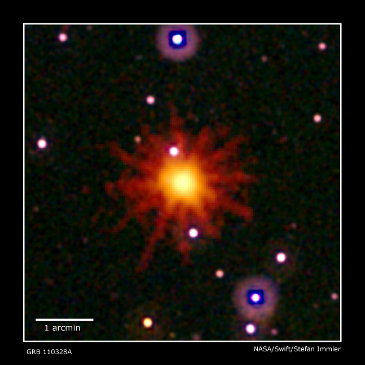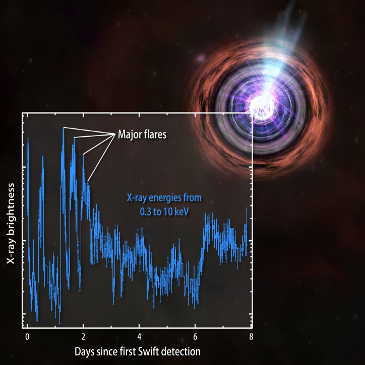| Date | News | ||||
|---|---|---|---|---|---|
| Oct 28, 2015 | Swift catches its 1000th Gamma-ray Burst! Swift 1000th gamma-ray burst (GRB), detected on October 27 2015, has triggered the usual flurry of mail announcements by optical and radio observers who hurried to their instruments to search for the afterglow of the high-energy event. The event is named GRB 151027B to reflect the date of the detection. Gamma-ray bursts are the most energetic explosions in the universe. The typically last about a minute and are located randomly across the sky. GRB 151027B had a duration of about 50 seconds. They are flashes of gamma rays produced when black holes are formed and are often referred to as the birth cries of black holes. GRBs are classified according to the duration of the event: long ones (which account for roughly 90% of the detections) last for more than 2 seconds, short ones can be over in few milliseconds. More than half of the SWIFT GRBs have been seen at optical wavelengths and 60% of such detections yielded a redshift measurement making it possible to gauge precisely the distance of the events. After more than 10 years of operations, 1000 GRBs and 6300 Target of Opportunity observations, Swift is expanding its grasp by providing coverage for gravitation wave alerts as well as for neutrino events. Swift, launched in November 2004, is a NASA mission with international participation from the United States, the United Kingdom, and Italy. The Italian participation includes the provision of the Malindi ground station (ASI), the mirrors of the X-ray Telescope (INAF-OAB) and the ASI Science Data Center (ASDC) which hosts an official mirror of the Swift scientific data archive and has the responsibility of the development of the Data Reduction Software for the XRT instrument on board Swift (XRTDAS). 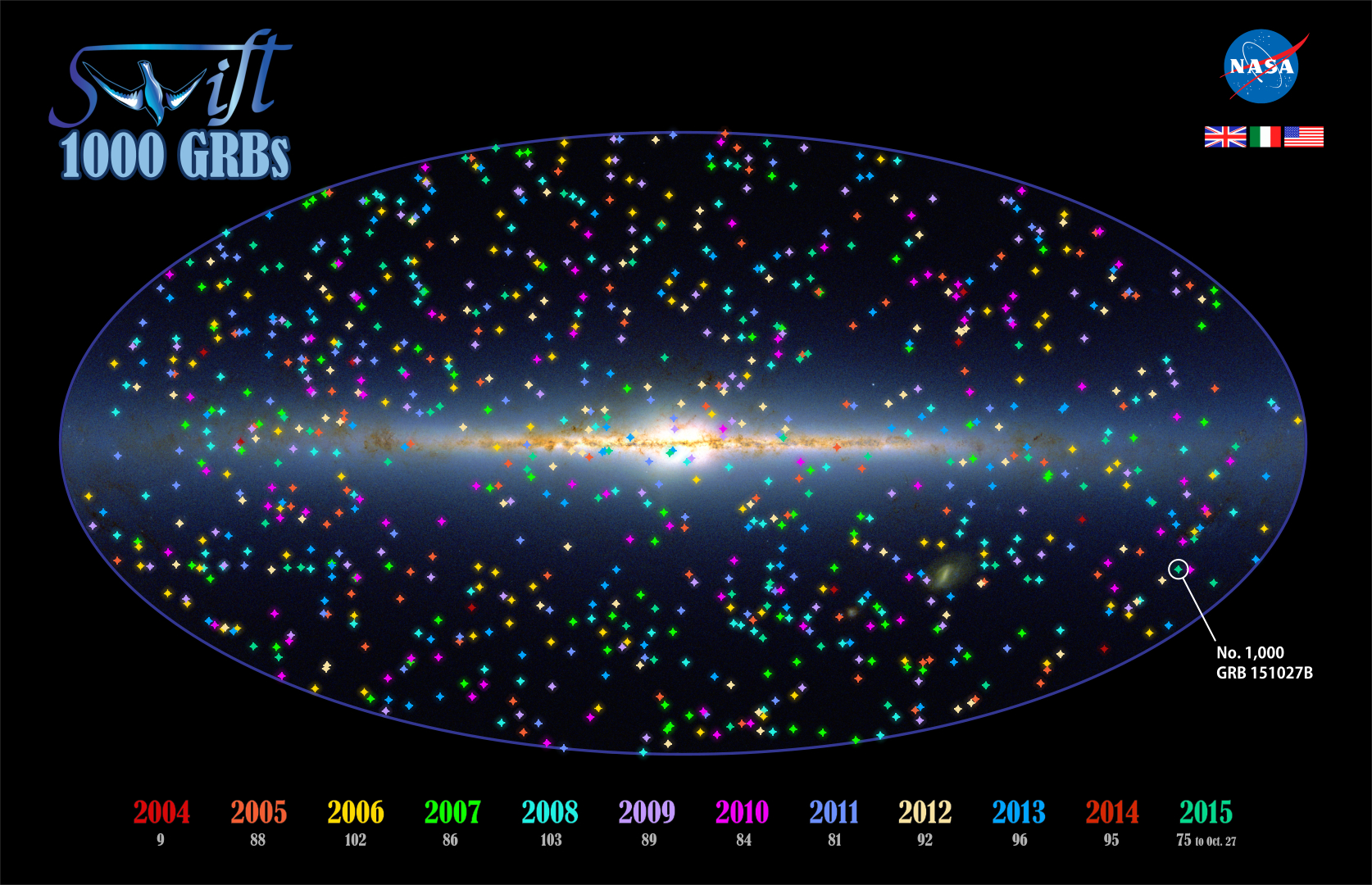 Positions of the first 1,000 Swift GRBs on an all-sky map of our galaxy, the Milky Way. Bursts are color coded by year, and the location of GRB 151027B is shown at lower right. An annual tally of the number of bursts Swift has detected appears below the label for each year. Background: An infrared view from the Two Micron All-Sky Survey.[Credits: NASA's Goddard Space Flight Center and 2MASS/J. Carpenter, T. H. Jarrett, and R. Hurt] | ||||
| Jan 13, 2015 | New release of the ASDC Swift/UVOT on-line imaging tool An new release of the ASDC Swift/UVOT on-line imaging tool has been recently published. This new version is based on the updated ASDC imaging tools window layout originally developed for the AGILE one and applied to Swift/XRT data, with an improved display capabilities such as plot recentering and smoothing, and improved catalogs overlay. Moreover a new detection parameter, "Quality Filter", has been added and a faster processing procedure released. Further updates to the analysis capabilities together with a new simple "interactive" user defined analysis will be released in the future. | ||||
| Oct 09, 2012 | Swift discovers a new black hole in our Galaxy On Sept. 16, the Swift satellite detected a rapidly brightening source located a few degrees from the center of our Milky Way galaxy. This source, named Swift J1745-26, is thought to be an X-ray nova and produced an outburst that revealed the presence of a previously unknown black hole. The black hole should be a member of a low-mass X-ray binary (LMXB) system, which includes a normal, sun-like star and a compact object. A stream of gas flowing from the normal star toward the black hole produced a stream of X-rays detected by the Swift instruments. "Bright X-ray novae are so rare that they're essentially once-a-mission events and this is the first one Swift has seen," said Neil Gehrels, the mission's principal investigator, at NASA's Goddard Space Flight Center. Swift, launched in November 2004, is a NASA mission with international participation from the United States, the United Kingdom, and Italy. The Italian participation includes the provision of the Malindi ground station (ASI), the mirrors of the X-ray Telescope (INAF-OAB) and the ASI Science Data Center (ASDC) which hosts an official mirror of the Swift scientific data archive and has the responsibility of the development of the Data Reduction Software for the XRT instrument on board Swift (XRTDAS). The new exciting result obtained by Swift was announced by NASA on October 5. For more details on this topic see the NASA pages and the news (in italian) on the INAF and ASI web sites.  Swift J1745-26. image taken on September 18, 2012 when the source peaked in hard X-rays. Credit: NASA/Goddard Space Flight Center/S. Immler and H. Krimm | ||||
| April 11, 2011 | Swift discovers puzzling cosmic gamma-ray source On March 28, Swift's Burst Alert Telescope discovered a new gamma-ray source cataloged as gamma-ray burst (GRB) 110328A. Astronomers immediately realized that this source is very peculiar, being very bright with a peculiar strong flaring activity lasting much longer than in all other GRBs. Following the Swift discovery, several ground and space telescopes observed this puzzling cosmic source. A deep image in the optical band taken by the Hubble Space Telescope revealed that the source of the explosion is located at the center of a galaxy distant about 3.8 billion light-years away from Earth. In the X-rays, the Chandra X-ray Observatory showed that the source lies at the center of the galaxy Hubble imaged. Observations of this source are still ongoing. Astronomers think this strong energy emission could arise from the disruption of a star wandered too close to its galaxy's central massive black hole. In particular, the X-rays may be coming from matter moving near the speed of light in a particle jet that forms along the rotation axis of the spinning black hole as the star's gas falls into a disk around the black hole. For more information and images associated with these observations, visit: http://www.nasa.gov/topics/universe/features/star-disintegration.html
| ||||
| May 13, 2010 | Swift discovered a long gamma-ray burst GRB 100513A at z~4.8 On May 13, at 02:07:08 UT, the Swift Burst Alert Telescope (BAT) triggered and located a distant long Gamma-Ray Burst GRB 100513A. Thanks to the Swift X-ray Telescope (XRT), the X-ray afterglow was detected and localized with 2.5 arcseconds uncertainty only two minutes after the burst trigger. Several ground based observations revealed the optical counterpart within 1 hour after the trigger. The redshift of this burst has been estimated z=4.772 through the optical afterglow spectrum, taken 4.1 hours after the burst with the 8 m Gemini North telescope. So far, about 15 GRBs have been detected with z>4. More details on this discover can be found here. | ||||
| April 19, 2010 | Swift catches its 500th Gamma-ray Burst! On April 13 Swift discovered GRB 100413B in the constellation Cassiopeia, the 500th burst detected during its five years life. It is a long burst, a type usually associated with the death of a massive star. Swift satellite was launched in November 2004 and primarily studies gamma-ray bursts (GRBs), the biggest and most mysterious explosions in the cosmos. "Each burst has turned over a new piece of the puzzle and a clearer picture is emerging." said Neil Gehrels, Swift's lead researcher at Goddard Space Flight Center in Greenbelt, USA. The figure shows the locations of Swift's 500 gamma-ray bursts, color coded by the year in which they occurred. In the background, an infrared image shows the location of our galaxy. Cick here to view the video showing the GRB highlights of the Swift mission. For more details see the NASA press release, the INAF press release and the news on the ASI site. 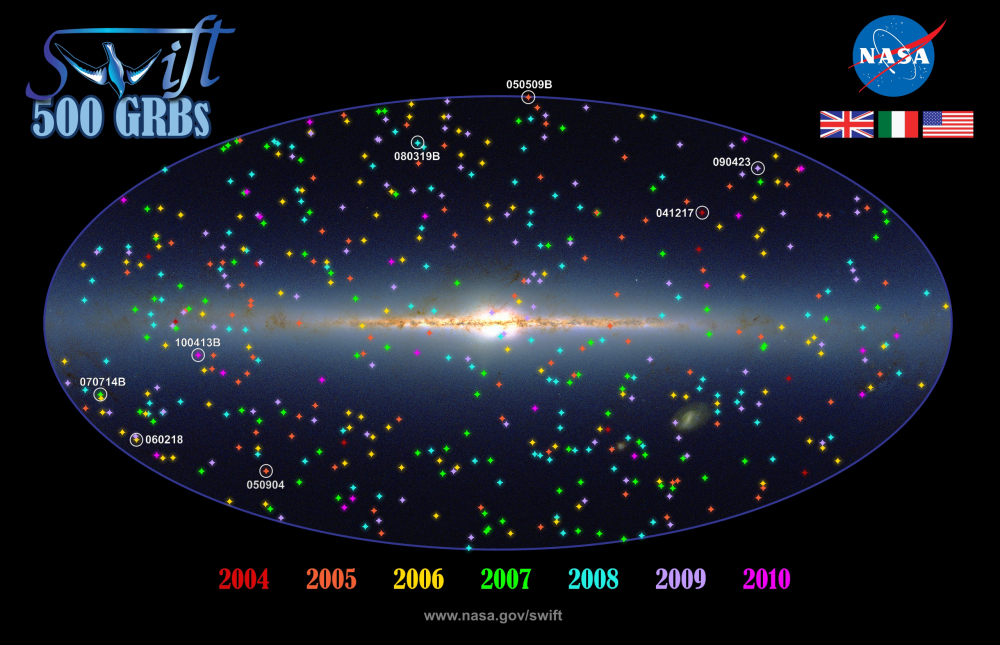 Credit: NASA/Swift/Francis Reddy | ||||
| April 13, 2010 | Swift discovered a long gamma-ray burst GRB 100431A On April 13, 2010 at 17:33:28 UT, the Swift Burst Alert Telescope (BAT) triggered and located a long gamma-ray burst named GRB 100413A. As for many GRBs, the burst started before the detector trigger time T, at ~T-45 s. A first cluster of peaks ends at ~T+40 s followed by a second one starting around T+90 s, up to T+240 s. The emission does not return to background between the two clusters. Swift slewed to the burst 140 s after the trigger and the X-ray telescope XRT revealed the X-ray afterglow. No optical counterpart was detected with the UV-optical telescope UVOT on board Swift and with several ground based optical telescopes. A tentative redshift of this burst was estimated from X-ray analysis of the photoelectric absorption. The higher significance solution was found for very large distances (redshift z~4). Although low redshift solution cannot be excluded yet, the high redshift solution compares well with the non-detection of the optical afterglow counterpart with UVOT and other robotic telescopes. More details on this discover can be found here. | ||||
| March 19, 2010 | Swift discovers a new Soft Gamma Repeater SGR 1833-0832 On March 19, 2010, at 18:34:50 UT, the Swift Burst Alert Telescope triggered and located a very short (16 ms) and soft (<100 keV) burst near the Galactic plane. The burst was soon recognized to be a burst from a new Soft Gamma Repeater (SGR) enabling its discovery and classification as SGR 1833-0832. Following the Swift discovery of the new SGR, a ToO program was activated with RXTE on 2010, March 19 and a coherent pulsations from the new SGR in the 2-20 keV PCA data at 0.1321 Hz was detected, corresponding to a spin period of 7.57 sec. Timing analysis on Swift/XRT data in PC mode confirmed the period detection, further confirming the discovery of a new, burst-active SGR. Archival Chandra ACIS-S observations of the field of the newly discovered Soft Gamma Repeater SGR 1833-0832 show no point source within the best Swift XRT error circle on 2009 February 13 with 8 ks of exposure. All the circulars (GCN) of SGR 1833-0832 can be found here. | ||||
| March 16, 2010 | Four Gamma-ray Bursts have been detected with Swift within 02:23 UT and 12:44 UT Four Gamma-ray bursts detected in the very same day is an extremely rare event since these objects have an average detection rate of about 1 each 3 days. Among hundreds of detected GRBs, there is only one analogous case of four GRBs detected on March, 19 2008. GRB 100316A, a Fast Rise Exponential Decay (FRED) 7 s long burst, was detected on March, 16 at 02:23:00 UT with Swift/BAT: an X-ray afterglow was detected and a tentative optical counterpart has been identified. All the Gamma-Ray bursts Coordinates Network Circulars (GCN) of GRB 100305A can be found here . At 08:01:36 UT a second burst, named GRB 100316B, was detected with Swift/BAT, with 5 s long multi-peak light curve. An X-ray afterglow with an optical counterpart was detected with Swift/XRT and Swift/UVOT, as well as from several ground based telescopes (GROND, Skynet/PROMPT, VLT/X-shooter). Optical spectral analysis performed with VLT/X-shooter shows several absorption features at a common redshift of z=1.180. All the Gamma-Ray bursts Coordinates Network Circulars (GCN) of GRB 100305B can be found here . A third GRB (100316C) triggered Swift/BAT at 08:57:59 UT of the same day. The BAT light curve showed a single-peaked structure with a duration of about 7 sec. An X-ray afterglow was detected with Swift/XRT. A possible optical counterpart was detected with the ground-based robotic telescope GROND. All the Gamma-Ray bursts Coordinates Network Circulars (GCN) of GRB 100305C can be found here . At 12:44:50 UT GRB 100316D was detected with Swift/BAT. The burst and the X-ray afterglow light curves and spectra are very non-typical for a GRB and similar to the GRB060218-SN2006aj burst (Campana, et al.; Nature, v224, p1008, Figure 1). The 5 arcsec XRT error circle, covers the edge of an extended DSS optical object. Two optical sources, consistent with the X-ray afterglow error circle, were resolved with the ground-based telescopes VLT/X-shooter and Gemini/GMOS. In the X-shooter spectra of both sources, several bright emission lines have been detected at a common redshift of 0.059, suggesting that these are two regions of a nearby galaxy. It is still unknown if this nearby galaxy is related with GRB 100316D. Further analysis and observations are in progress. A tentative redshift has been estimated from X-ray data analysis in the range 0.014 < z < 0.6. All the Gamma-Ray bursts Coordinates Network Circulars (GCN) of GRB 100305D can be found here . | ||||
| March 5, 2010 | The Swift Burst Alert Telescope (BAT) triggered and located the gamma-ray burst GRB 100305A The Swift Burst Alert Telescope (BAT) triggered and located the long GRB 100305A. The BAT light curve showed a single-peaked structure with a total duration of about 20 sec. Swift slewed about 2 minutes after the burst and the afterglow X was detected with XRT. The X-ray light curve shows a single bright flare followed by a power law decay. No optical source has been found in the XRT error circle from space and ground-based observations, making this burst a good high-redshift source candidate although high dust extinction cannot be excluded yet. All the Gamma-Ray bursts Coordinates Network Circulars (GCN) of GRB 100305A can be found here. | ||||
| March 3, 2010 | The Swift Burst Alert Telescope (BAT) triggered and located the gamma-ray burst GRB 100302A The Swift Burst Alert Telescope (BAT) triggered and located GRB 100302A. Swift slewed 2 minutes after the burst and the afterglow X was detected with the Swift X-ray telescope XRT. The X-ray light curve shows an intense flaring activity followed by the canonical shallow decay phase. A fading optical source has been found in the XRT error circle from ground-based observations, identified as the afterglow optical counterpart. All the Gamma-Ray bursts Coordinates Network Circulars (GCN) of GRB 100302A can be found here. | ||||
| February 19, 2010 | The Swift Burst Alert Telescope (BAT) triggered and located the gamma-ray burst GRB 100219A (19 Feb. 2010) The Swift Burst Alert Telescope (BAT) triggered and located GRB 100219A. Swift slewed 3 minutes after the burst and detected the afterglow both with XRT and UVOT. Several ground based optical telescopes have monitored the afterglow. In particular, observations performed with the VLT equipped with the X-shooter spectrograph taken 0.47 days after the burst, revealed a redshift of z=4.7 and several intervening systems along the line of sight. All the Gamma-Ray bursts Coordinates Network Circulars (GCN) of GRB 100219A can be found here. | ||||
| September 17, 2009 | Swift makes the highest-resolution ultraviolet image of Andromeda Galaxy The Swift satellite has acquired the highest-resolution view ever obtained in the ultraviolet band of the eighboring spiral galaxy M31 also known as the Andromeda Galaxy. The Andromeda portrait is a mosaic of 330 images acquired between May 25 and July 26, 2008, for a total exposure time of 24 hours, by Swift's Ultraviolet/Optical Telescope (UVOT). UVOT observed M31 at three different wavelengths (192.8, 224.6, and 260 nanometers) and revealed about 20,000 ultraviolet sources in a region 200,000 light-years wide. Several features are apparent in the new mosaic like the striking difference between the galaxy's central bulge and its spiral arms. "Swift is surveying nearby galaxies like M31 so astronomers can better understand star-formation conditions and relate them to conditions in the distant galaxies where we see gamma-ray bursts occurring" said Neil Gehrels, the Swift mission's principal investigator at NASA Goddard Space Flight Center. For more details see: http://www.asi.it/it/news/andromeda_in_look_ultravioletto (italian) http://www.nasa.gov/mission_pages/swift/bursts/uv_andromeda.html (english) A video with the data taken by Swift UVOT instrument is available at: http://anon.nasa-global.edgesuite.net/anon.nasa-global/ccvideos/swift_tour_m31.asx | ||||
| August 12, 2009 | "Swift Mission Conference: Celebrating 5 Years" - November 18th - 20th, 2009 The "5 Years of Swift" meeting will be held in State College, Pennsylvania on November 18th - 20th, 2009. A preliminary program and other information are available at the conference website: http://www.outreach.psu.edu/programs/swift-2009/index.html | ||||
| May 21, 2009 | Muhlmann Award 2009 to the Swift team The Swift Mission team has won the Maria and Eric Muhlmann Award 2009 of the Astronomical Society of the Pacific for "recent significant observational results made possible by innovative advances in astronomical instrumentation, software, or observational infrastructure." | ||||
| May 4, 2009 | Swift discovers the most distant object in the Universe At 07:55 UT on April 23 the Swift satellite detected the gamma-ray burst GRB 090423 and promptly slewed to observe it with the X-ray and ultraviolet/optical telescopes. Just after 72 seconds from the trigger, the Swift X-ray telescope began observing the field of the burst and found a fading and uncatalogued X-ray source which allowed a very accurate localization of the burst (~2 arcseconds). Following the Swift detection, several on-ground telescopes observed the event and found that its distance was about 13 billion light-years (corresponding to a redshift of 8.1), making GRB 090423 the most distant object ever seen. At the epoch of the burst, the Universe was less than 5% of its present age when only the earliest generations of stars were present. 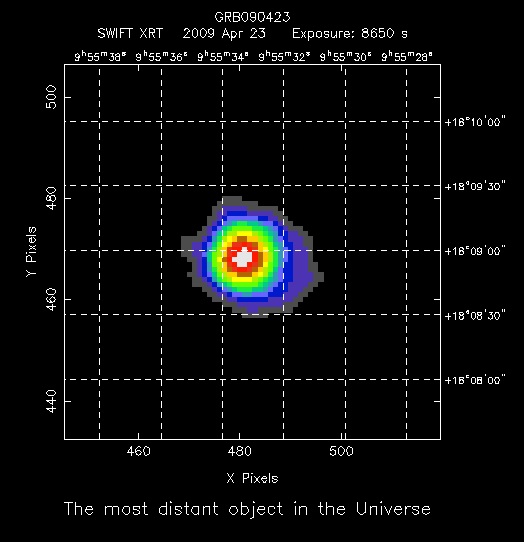 Swift-XRT image of the afterglow of GRB 090423 | ||||
| April 29, 2008 | Swift detection of the brightest X-ray flare from S50716+714 On 28 April 2008 Swift detected the blazar S50716+714 at X-ray and UV flux levels significantly larger than ever observed before. An analysis of the XRT data gives a 0.3-10 keV X-ray flux of 4e-11 erg/cm2/s, about 50% larger than that observed at the peak of the giant X-ray flare of October-November 2007. Swift will continue the monitoring of S50716+714 over the next few days, while the AGILE Gamma-ray observatory will include this source within its field of view between April 30 and May 10, 2008. Multi-frequency observations are strongly encouraged (ATel.#1495, Giommi et al.) | ||||
| January 12, 2007 | Rossi Prize 2007 for Swift The Rossi Prize 2007 of the American Astronomical Society is awarded to Swift. The citation begin something like this: "Neil Gehrels and the Swift Team for gamma-ray burst discoveries with the Swift mission ..." "This is a great recognition of all the wonderful science coming from Swift ...", Neil Gehrels wrote. | ||||


